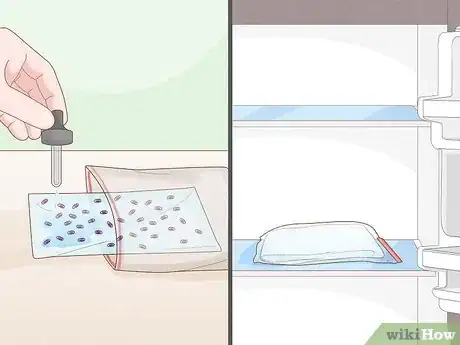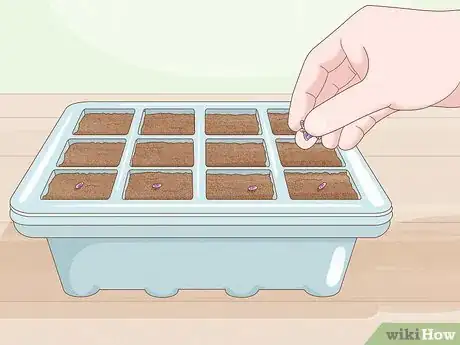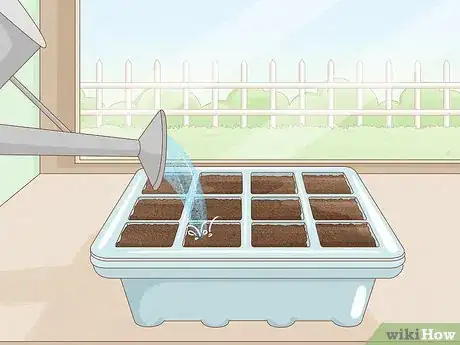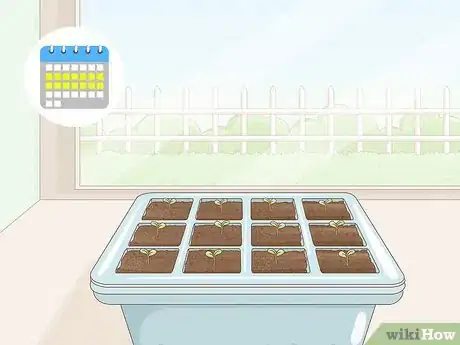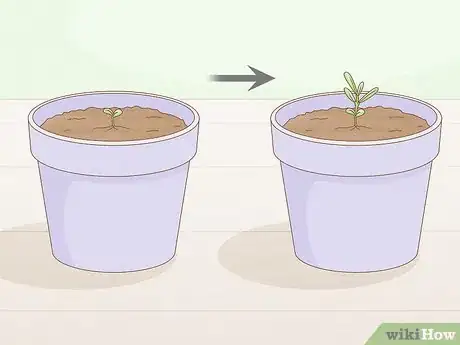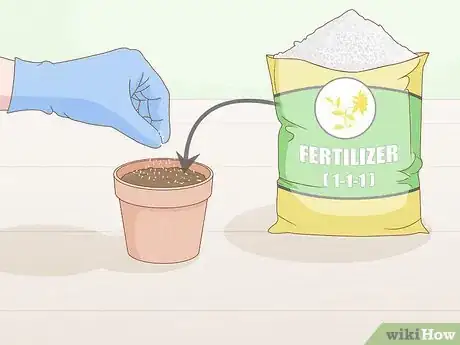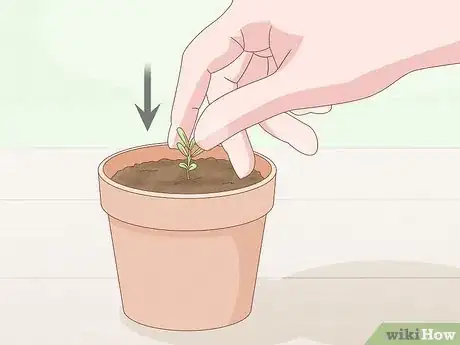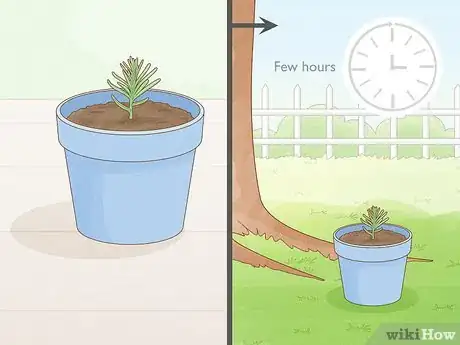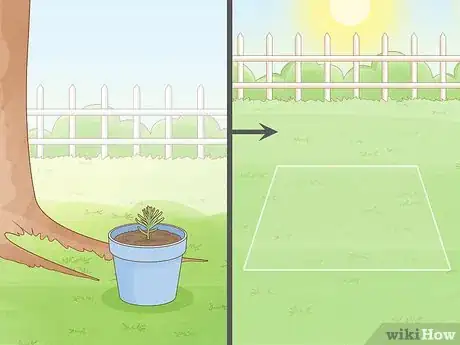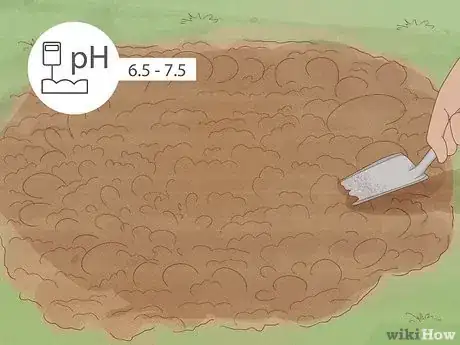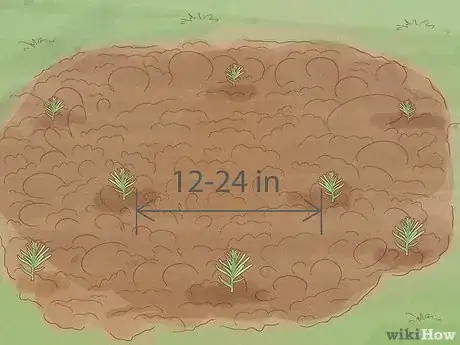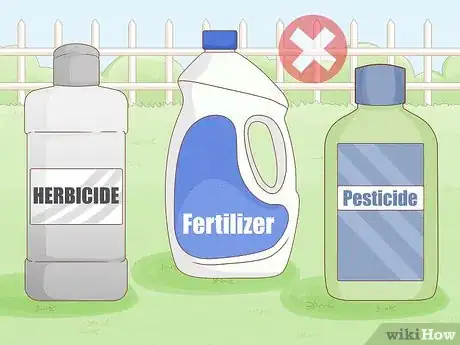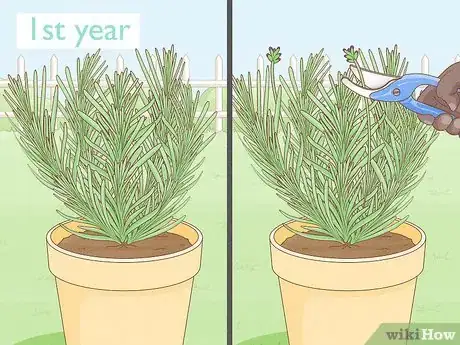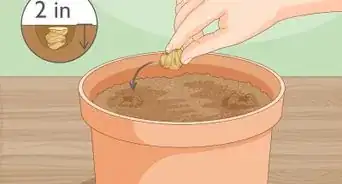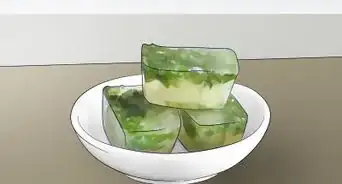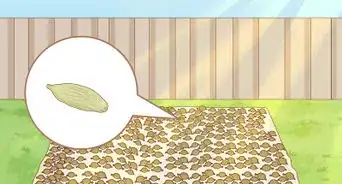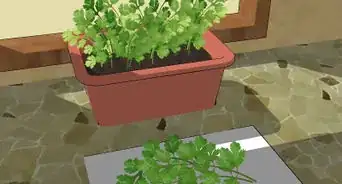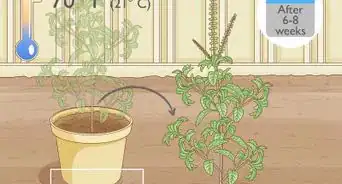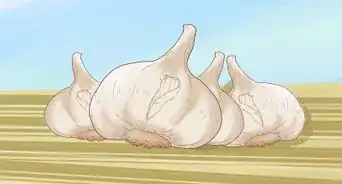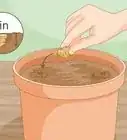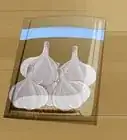This article was co-authored by Lauren Kurtz. Lauren Kurtz is a Naturalist and Horticultural Specialist. Lauren has worked for Aurora, Colorado managing the Water-Wise Garden at Aurora Municipal Center for the Water Conservation Department. She earned a BA in Environmental and Sustainability Studies from Western Michigan University in 2014.
wikiHow marks an article as reader-approved once it receives enough positive feedback. This article received 29 testimonials and 94% of readers who voted found it helpful, earning it our reader-approved status.
This article has been viewed 627,666 times.
Lavender is a beautiful, fragrant herb that produces purple, white, and/or yellow flowers, depending on the specific variety. Most gardeners usually propagate lavender from cuttings, but the plant can also be grown from seed. Growing lavender from seed is not always successful and is a fairly slow process, but the method is often less costly than buying cuttings or pre-started lavender plants and can eventually produce plants that are just as vibrant. If you choose to harvest your own lavender seeds, keep in mind that some plants won't produce seeds that are true to the plant.[1]
Steps
Germinating Seeds
-
1Start the seeds 6 to 12 weeks before warm weather hits. Lavender seeds can take a while to germinate and should be started early indoors so that they have plenty of time to grow into mature plants during the warm growing season.[2]
-
2Put harvested seeds through a process called "cold stratifying." Place your seeds between 2 wet paper towels, then put them into a sealable plastic bag. Store the bag with the seeds in the refrigerator, leaving it there for at least 3 weeks.[3]
- If you purchased your seeds, they've already gone through this process. Only stratify your seeds if you harvested them yourself from another plant.
Advertisement -
3Fill a container with seed starting mix. The seed starting mix should be a light potting mix that drains well. You can either use a plastic seedling tray or a wide, shallow container without divisions.
-
4Plant the seeds. Sprinkle the seeds on top of the soil. There's no need to bury the seeds, but you should sprinkle a light layer of soil over the seeds.[4]
- If using a plastic seedling tray, plant one seed per slot.
- If planting in a division-free container, space the seeds 1/2 to 1 inch (1.27 to 2.54 cm) apart.
-
5Cover the seeds with 1/8 inch (1/3 cm) potting mix. A light coating of potting mix protects the seeds, but the seeds also need access to sunlight in order to germinate.
-
6Keep the seeds in a warm spot. A heat tray often works best, but another work location may also work as long as the temperature remains around 70 degrees Fahrenheit (21 degrees Celsius).
-
7Lightly water the seeds. Keep the growing medium moist, but not damp, and water the seeds in the morning so that the soil can dry some before evening hits. Soil that is too damp and cool will invite fungus to grow, and fungus will destroy your seeds.
-
8Wait for your seeds to sprout. Lavender seeds can take two weeks to one month to sprout. Monitor your seeds while you wait for them to sprout. Make sure the soil stays wet while you wait for them to sprout, and keep the seeds in a sunny area.[5]
-
9Give sprouted seeds plenty of light. After the seeds sprout, you should move the container to a location that receives plenty of direct sunlight. If no such location is available, place a fluorescent grow light about the sprouts and allow them to sit in the artificial light for eight hours a day.
Transplanting
-
1Make the first transplant after lavender gets several sets of leaves. Wait until the leaves are "true leaves," or fully matured. At that point, the root system will have grown too large to continue sitting in a shallow tray.
-
2Fill a larger container with well-drained potting mix. You no longer have to seed starting mix, but the potting mix you do use should be light. Look for mixes that are made of part soil and part peat, part perlite. Peat moss is a non-renewable resource, so it's best to use coir dust instead, if possible. Do not use vermiculite, which may contain asbestos, even when the label doesn't say so.
- The pot for each plant should be at least 2 inches (5 cm) in diameter. Alternatively, you can also use a larger pot or division-free tray and space multiple lavender plants in the tray 2 inches (5 cm) apart from one another.
-
3Mix a little fertilizer into the soil. Use a small amount of granular slow-release fertilizer that contains balanced proportions of nitrogen, phosphorus, and potassium.
-
4Place the lavender into the prepared pot. Dig a small hole in the fresh growing media that is about as big as the compartment the lavender presently sits in. Gently pry the lavender out of its original container and transplant it into the new hole, packing the soil around it to keep it firmly fixed in place.
-
5Allow the lavender to continue growing. The plants must reach a height of 3 inches (7.6 cm) before they can be transplanted to their final location, but they should still only have a single stem. This could take anywhere from one to three months.
-
6Expose the lavender to outdoor conditions slowly. Place your pots outdoors in partial shade or partial sun for a few hours at a time, increasing the time outdoors a little each day. Do this for about one week, just long enough for the lavender to have time to adapt to outdoor conditions.
- This is a process called "hardening off."
-
7Choose a sunny location. Lavender plants do best when grown in full sun. Shaded areas tend to be soggier, and soggy soil can invite fungi that will destroy the plant.
-
8Prepare the garden soil. Chop the soil up with a trowel or digging fork to loosen it and mix in a healthy dose of compost. Compost has uneven particles, creating looser soil and making it easier for roots to stretch out. Additionally, the loose soil allows the water to flow freely.
- Check the soil of the pH after adding compost. The soil pH should rest between 6 and 8, and preferably between 6.5 and 7.5 for best results. If soil pH is too low, mix in agricultural lime. If it is too high, add a small amount of plant litter pine sawdust.[6]
- If your area has a damp winter or spring, you need to plant your lavender on a mound. When you dig out your hole, mix gravel into the soil at the bottom, beneath the root ball. If your lavender's roots stay wet during the winter, it'll die.
-
9Transplant the lavender plants 12 to 24 inches (30 1/2 to 61 cm) apart. Dig a hole that is as deep as the container the plant currently grows in. Remove the plant from its pot, using a garden trowel to carefully slide it out, and plant the lavender into the new hole.
Daily Care
-
1Water the lavender only when dry. Mature lavender is fairly drought-resistant, but while lavender is within its first year of growth, it needs regular watering. Normal weather conditions often suffice, but if you live in an area that is particularly dry or if you have not received much rain, you should regularly soak the soil. Allow the soil to dry out in between watering, though.
-
2Avoid chemicals. Herbicides, pesticides, and even fertilizers can kill the beneficial organisms that live in the garden soil and help your lavender to thrive. Skip the fertilizer altogether once planted in the ground. If a pesticide is needed, try an organic pesticide solution that contains no chemicals, since this is less likely to have a negative effect.
-
3Prune the lavender. Lavender grows slowly during the first year, and most of the plant's energy goes toward root development and vegetative growth. You should encourage this process by cutting off any flowering stems once the first buds begin to open during the first growing season.
- After the first year, cut flowering stems after 1/3 of the buds have opened to encourage further growth. Leave behind at least 1/3 of the new growth.
-
4Mulch during cold weather. Keep the soil warm by applying gravel or bark mulch around the base of the plant, leaving 6 inches (15 1/4 cm) of free space around the stem for air circulation.
Expert Q&A
Did you know you can get expert answers for this article?
Unlock expert answers by supporting wikiHow
-
QuestionCan you sow seeds directly in the ground?
 Lauren KurtzLauren Kurtz is a Naturalist and Horticultural Specialist. Lauren has worked for Aurora, Colorado managing the Water-Wise Garden at Aurora Municipal Center for the Water Conservation Department. She earned a BA in Environmental and Sustainability Studies from Western Michigan University in 2014.
Lauren KurtzLauren Kurtz is a Naturalist and Horticultural Specialist. Lauren has worked for Aurora, Colorado managing the Water-Wise Garden at Aurora Municipal Center for the Water Conservation Department. She earned a BA in Environmental and Sustainability Studies from Western Michigan University in 2014.
Professional Gardener Yes, you can sow the seeds directly into the ground, but this method is less successful than starting your seeds indoors. Your seedlings will need more care and attention than an outdoor bed can provide. If you start your seeds indoors or in a greenhouse, you can make sure your seeds have the right conditions to sprout.
Yes, you can sow the seeds directly into the ground, but this method is less successful than starting your seeds indoors. Your seedlings will need more care and attention than an outdoor bed can provide. If you start your seeds indoors or in a greenhouse, you can make sure your seeds have the right conditions to sprout. -
QuestionShould I nip the tops of lavender seedlings?
 Lauren KurtzLauren Kurtz is a Naturalist and Horticultural Specialist. Lauren has worked for Aurora, Colorado managing the Water-Wise Garden at Aurora Municipal Center for the Water Conservation Department. She earned a BA in Environmental and Sustainability Studies from Western Michigan University in 2014.
Lauren KurtzLauren Kurtz is a Naturalist and Horticultural Specialist. Lauren has worked for Aurora, Colorado managing the Water-Wise Garden at Aurora Municipal Center for the Water Conservation Department. She earned a BA in Environmental and Sustainability Studies from Western Michigan University in 2014.
Professional Gardener
-
QuestionWhat do lavender seedlings look like?
 Community AnswerMost species of lavender seedlings will have one (1) stem and two (2) small leaves at the top.
Community AnswerMost species of lavender seedlings will have one (1) stem and two (2) small leaves at the top.
Things You’ll Need
- Lavender seeds
- Loose soil
- Seedling tray
- Small pots
- Trowel
- Garden fork
- Granular slow-release fertilizer
- Heat tray
- Spray bottle
- Garden hose
- Soil pH tester
- Shears or scissors
- Mulch
References
- ↑ https://www.gardeningknowhow.com/edible/herbs/lavender/lavender-seed-propagation.htm
- ↑ https://www.gardeningknowhow.com/edible/herbs/lavender/lavender-seed-propagation.htm
- ↑ https://www.gardeningknowhow.com/edible/herbs/lavender/lavender-seed-propagation.htm
- ↑ https://www.gardeningknowhow.com/edible/herbs/lavender/lavender-seed-propagation.htm
- ↑ https://www.gardeningknowhow.com/edible/herbs/lavender/lavender-seed-propagation.htm
- ↑ http://www.mountainvalleygrowers.com/lavendercareandtips.htm
About This Article
To grow lavender from seed, start by putting the seeds in a sealable plastic bag filled with moist soil and storing it in the refrigerator for 3 weeks. Next, plant the seeds in a container filled with seed starting mix and cover them with ⅛ inch of potting mix. Then, keep the container in a warm place, and water the seeds every morning for 2 to 4 weeks until they sprout. Afterwards, move them to an area with direct sunlight, then transplant them into individual pots once the sprouts develop leaves. For more advice, including how to plant the lavender sprouts in your outdoor garden, keep reading.

